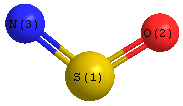Vibrational Frequencies calculated at B2PLYP=FULL/6-31+G**
| Mode Number |
Symmetry |
Frequency
(cm-1) |
Scaled Frequency
(cm-1) |
IR Intensities
(km mol-1) |
Raman Act
(Å4/u) |
Dep P |
Dep U |
|---|
| 1 |
A' |
1276 |
1213 |
17.69 |
25.01 |
0.51 |
0.68 |
| 2 |
A' |
1132 |
1076 |
150.93 |
11.23 |
0.50 |
0.67 |
| 3 |
A' |
300 |
285 |
44.96 |
7.01 |
0.54 |
0.70 |
Unscaled Zero Point Vibrational Energy (zpe) 1353.5 cm
-1
Scaled (by 0.951) Zero Point Vibrational Energy (zpe) 1287.2 cm
-1
See section
III.C.1 List or set vibrational scaling factors
to change the scale factors used here.
See section
III.C.2
Calculate a vibrational scaling factor for a given set of molecules
to determine the least squares best scaling factor.
